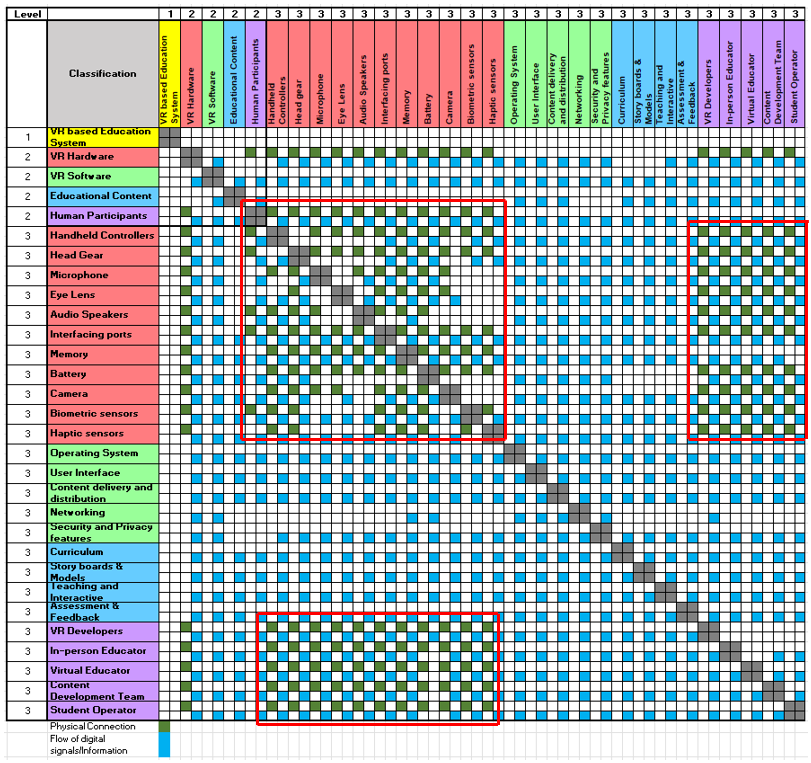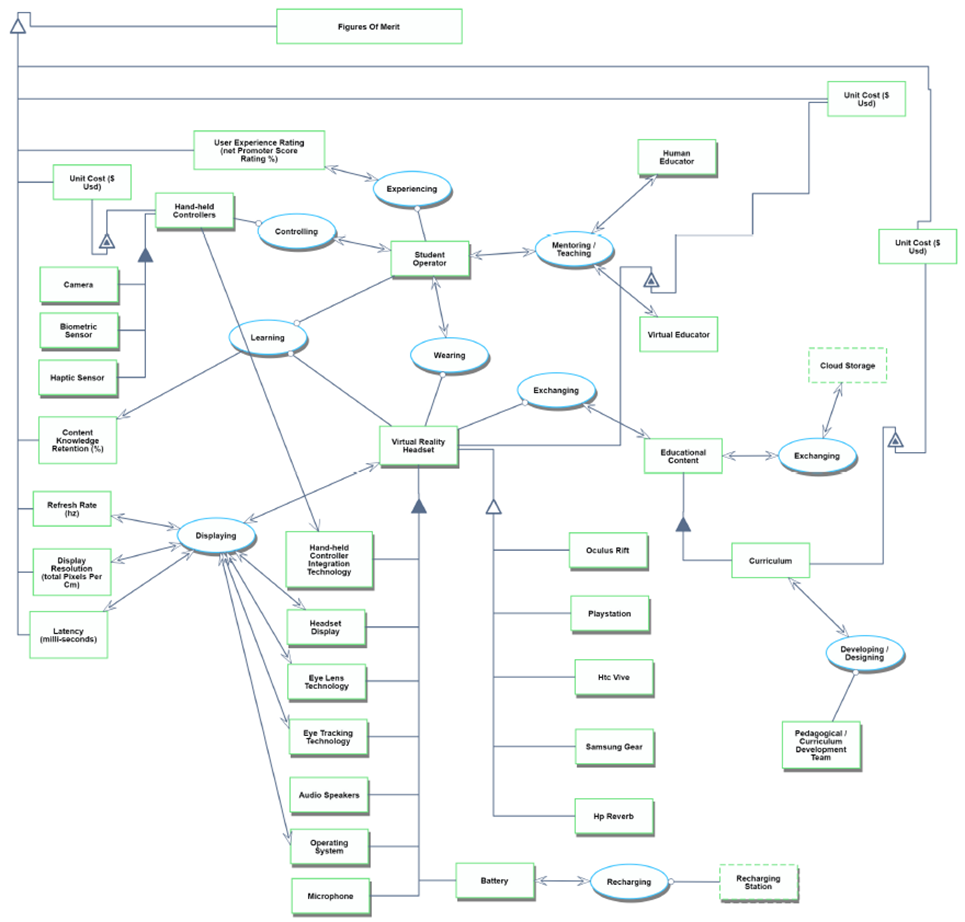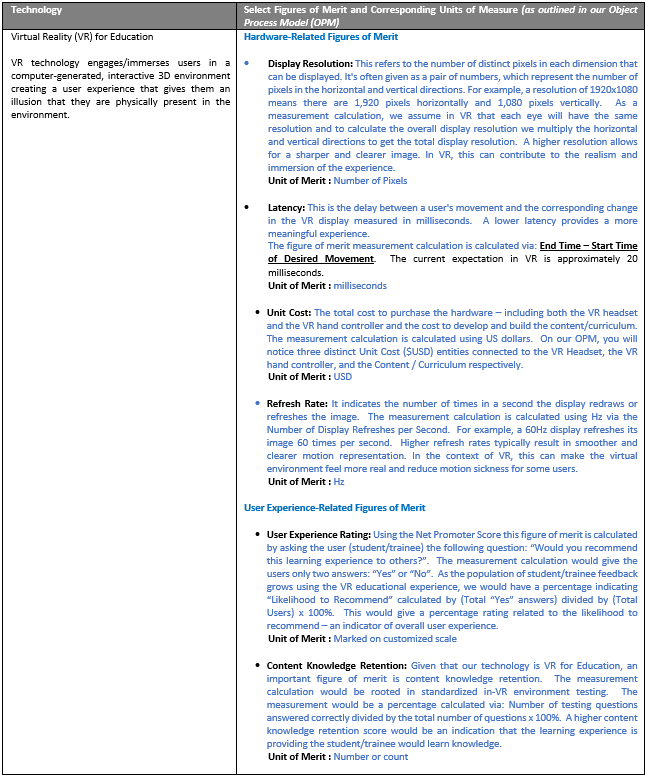Difference between revisions of "VREducation"
| Line 28: | Line 28: | ||
For VR-based education, the strategic drivers that the industry demands are listed here. The Strategic Drivers, motivation behind these drivers and the FOM targets are mentioned below. The goal here is not to pick the highest display quality, but to find a balance between the display, cost and the educational impact. | For VR-based education, the strategic drivers that the industry demands are listed here. The Strategic Drivers, motivation behind these drivers and the FOM targets are mentioned below. The goal here is not to pick the highest display quality, but to find a balance between the display, cost and the educational impact. | ||
[[File: | [[File:StrategicDriverVRed.png]] | ||
=Positioning of Company Vs. Competition : FOM charts= | =Positioning of Company Vs. Competition : FOM charts= | ||
Revision as of 12:44, 2 November 2023
Project Overview
Virtual Reality (VR) in education offers an immersive, interactive, and engaging environment, revolutionizing traditional education and teaching methods. By simulating real-world experiences, VR promotes experiential learning, allowing students to visualize complex concepts, explore inaccessible locales, and engage in realistic scenarios. VR technology fosters better comprehension, retention, and enthusiasm for subjects ranging from history to science to training in skilled labour industries and beyond. In classrooms, VR can transport students to ancient civilizations, distant planets, or even inside human cells. For skills training, such as medical or technical fields, VR provides safe, repeatable environments for practice, reducing risks and resource costs. Moreover, VR caters to diverse learning styles, accommodating visual, auditory, and kinesthetic learners. With the potential for global virtual classrooms, students from varied geographies and backgrounds can interact, democratizing education access. While challenges remain, including technological equity and motion sickness, the transformative potential of VR in education is undeniable.
Our technology roadmap identifies the importance of the integration between hardware technical capabilities – including the VR headset and hand-held devices – along with the educational content and curriculum. Getting both “right” is integral to the future utilization and success of using VR as an immersive learning tool. Our roadmap demonstrates that VR for education is still in the “Rapid Progress” phase of the traditional “S Curve” and countless additional / supplementary innovations are still forthcoming such as utilizing AI for bespoke / custom learning opportunities for students / trainees around the world. Our technology roadmap lives at the epicenter of three key aspects as outlined in Figure I below. This graphical representation integrates well with the Mixed Reality technology roadmap outlined in (https://roadmaps.mit.edu/index.php/Mixed_Reality_(Augmented_%26_Virtual)#Roadmap_Overview). The key difference is the extended and deliberate engagement of educational content and curriculum into our roadmap.
- Human Operator. This includes both the trainee and the instructor that may (or may not) be involved in the training and educational experience. Some of the hands-on technical training using VR may still leverage the opportunity for an in-person instructor such as training in hazardous situations or medical environments.
- Content / Curriculum and Learning Environment. Student / trainee educational outcomes are rooted in the development and deployment of the “right” educational content and curriculum in the VR immersive experience.
- VR Hardware / Computer Systems. The quality, cost, and user experience with the VR hardware and supporting computer systems will be integral to the success of our VR for Education technology development and deployment. Significant investments and progress has been made and continue to position VR to transform the global education market.
Position in Technology Matrix
Our technology of choice is VR for Education. Per below, VR for Education is indicated in the “Exchanging Information” category because it involves exchanging educational content in the form of information with students. The VR hardware (headset and hand controllers) combined with educational content is a mechanism to exchange information between a student/trainee and the content delivered/exchanged via the VR technology.
DSM Allocation
Roadmap Model using Object Process Methodology(OPM)
Figures of Merit
Alignment with Company Strategic Drivers : FOM Targets
For VR-based education, the strategic drivers that the industry demands are listed here. The Strategic Drivers, motivation behind these drivers and the FOM targets are mentioned below. The goal here is not to pick the highest display quality, but to find a balance between the display, cost and the educational impact.

Positioning of Company Vs. Competition : FOM charts
Technical Model : Morphological Matrix and Tradespace
Key Publication and Patents
Assessment of Augmented Reality Technology’s Impact on Speed of Learning and Task Performance in Aeronautical Engineering Technology Education[1]
In this paper the study compared the learning and skill transfer among University students using AR vs traditional paper-based instructions. The study resulted in showing how AR users had significantly reduced task execution times. Pre-task “gamification and play” were also observed among the AR users, which could impact how educators and the industry assess and leverage learning strategies when using AR for job task training.
A Systematic Review of AR and VR Enhanced Language Learning [2]
This paper provides a systematic review of previous Augmented Reality (AR) and Virtual Reality (VR) studies on language learning. The analysis was conducted according to the approaches of integrating AR and VR in language learning, the main users of AR and VR technologies, research findings, ways of AR and VR in improving language proficiency and research implications of previous research. In terms of research findings, most of the studies found AR and VR tools were effective in promoting learning, enhancing motivation and students held positive attitudes towards using those tools. Due to the effectiveness of AR and VR tools, there was an inevitable trend of integrating these tools in education. Direct manipulation is better than passive viewing for learning anatomy in a three-dimensional virtual reality environment The goal of this paper was to investigate the impact of direct manipulation in virtual reality on anatomy learning. Building upon prior research showing mixed findings for the role of direct manipulation in spatially-intensive learning environments they showed 1. how the hand-held VR controller was designed to be highly intuitive and enable movements that were spatially congruent with the actions that would be taken to manipulate a physical model. 2. This study incorporated a realistic anatomical structure, with a specific learning task, rather than a more abstract, “anatomy-like” structure. The results of the study demonstrate that 1) participants are capable of successfully embodying virtual representations of internal anatomical structures if they can control the presentation; 2) participants who passively view the movement of this structure are most successful when presented with a limited number of canonical viewpoints; and 3) where the VR environment is designed to be intuitive and similar to the physical interaction in the real world, it is the participants with low spatial ability who tend to benefit most from the advantages of manipulation and interactivity, as compared with those with high spatial ability.
Challenges and strategies for educational virtual reality[3]
This qualitative study invited experts from a range of disciplines and sectors to identify common challenges in the visualization and analysis of 3D data, and the management of VR programs, for the purpose of developing a national library strategy. In this paper major challenges identified are (1) interest and awareness for the emerging technology among faculty, students, and administrators (2) locating necessary expertise in VR within their communities when knowledge is unevenly distributed (3) getting enough buy-in from administrators to support the allocation of necessary resources (4) encouraging researchers to share their projects and research outputs for the benefit of the larger community.
References
[1] Kristoffer B. Borgen, Timothy D. Ropp & William T. Weldon (2021) Assessment of Augmented Reality Technology’s Impact on Speed of Learning and Task Performance in Aeronautical Engineering Technology Education, The International Journal of Aerospace Psychology, 31:3, 219-229, DOI: 10.1080/24721840.2021.1881403
[2] Josef Wolfartsberger, Jan Zenisek, Norbert Wild, Supporting Teamwork in Industrial Virtual Reality Applications, Procedia Manufacturing, Volume 42,2020, Pages 2-7, ISSN 2351-9789, https://doi.org/10.1016/j.promfg.2020.02.016.
[3] Cook, M. ., Lischer-Katz, Z., Hall, N., Hardesty, J., Johnson, J., McDonald, R., & Carlisle, T. (2019). Challenges and Strategies for Educational Virtual Reality: Results of an Expert-led Forum on 3D/VR Technologies Across Academic Institutions. Information Technology and Libraries, 38(4), 25–48. https://doi.org/10.6017/ital.v38i4.11075
[4] Marougkas, A.; Troussas, C.; Krouska, A.; Sgouropoulou, C. Virtual Reality in Education: A Review of Learning Theories, Approaches and Methodologies for the Last Decade. Electronics 2023, 12, 2832. https://doi.org/10.3390/electronics12132832
[5] Noble, S.M., Saville, J.D. & Foster, L.L. VR as a choice: what drives learners’ technology acceptance?. Int J Educ Technol High Educ 19, 6 (2022). https://doi.org/10.1186/s41239-021-00310-w
[6] Helsel, Sandra. “Virtual Reality and Education.” Educational Technology, vol. 32, no. 5, 1992, pp. 38–42. JSTOR, http://www.jstor.org/stable/44425644. Accessed 22 Oct. 2023.
[7] Cochrane, Thomas. "Mobile VR in Education: From the Fringe to the Mainstream." IJMBL vol.8, no.4 2016: pp.44-60. http://doi.org/10.4018/IJMBL.2016100104
[8] Y. Slavova and M. Mu, "A Comparative Study of the Learning Outcomes and Experience of VR in Education," 2018 IEEE Conference on Virtual Reality and 3D User Interfaces (VR), Tuebingen/Reutlingen, Germany, 2018, pp. 685-686, doi: 10.1109/VR.2018.8446486.
[9] Rojas-Sánchez, M.A., Palos-Sánchez, P.R. & Folgado-Fernández, J.A. Systematic literature review and bibliometric analysis on virtual reality and education. Educ Inf Technol 28, 155–192 (2023). https://doi.org/10.1007/s10639-022-11167-5
[10] Kuna, P.; Hašková, A.; Borza, Ľ. Creation of Virtual Reality for Education Purposes. Sustainability 2023, 15, 7153. https://doi.org/10.3390/su15097153
[11] Burov, O.Y. and Pinchuk, O.P., 2023. A meta-analysis of the most influential factors of the virtual reality in education for the health and efficiency of students’ activity. Educational Technology Quarterly [Online], 2023(1), pp.58–68. Available from: https://doi.org/10.55056/etq.435 [Accessed 22 October 2023].


